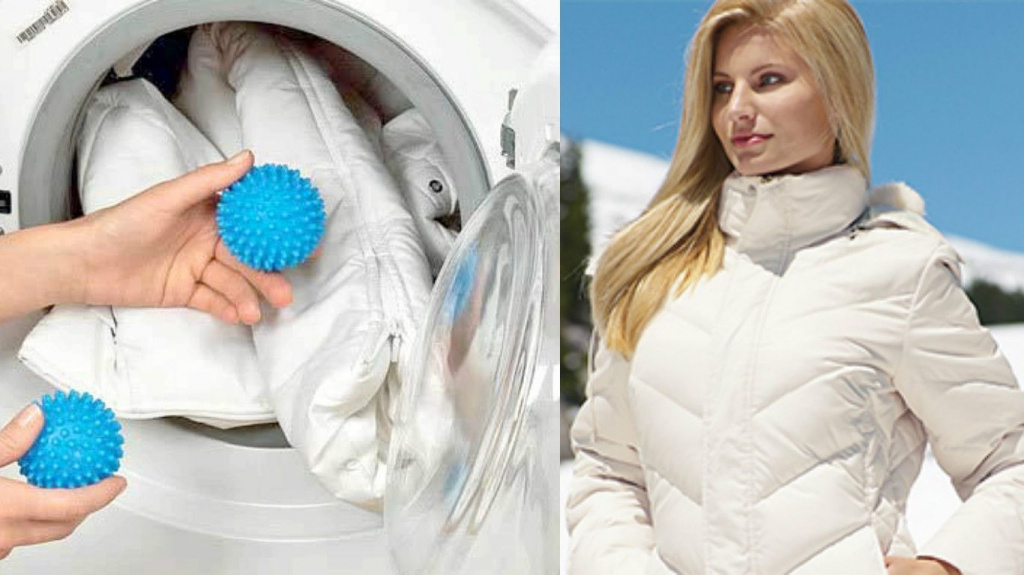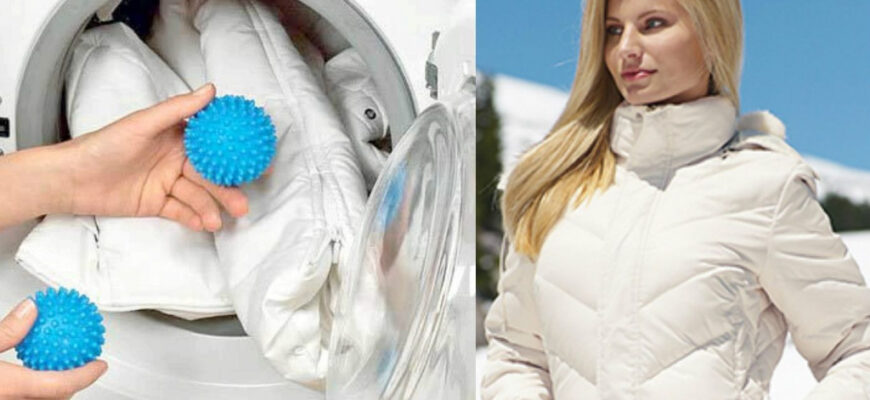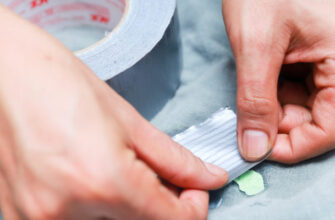Almost every family has products in which a synthetic winterizer is used as insulation: jackets, overalls, blankets or pillows. Unlike fluff or wool, this material is not demanding to care for, but improper washing can lead to loss of properties and an unsightly appearance of the thing. Employees of our magazine in various sources of information have found a lot of tips on how to properly wash synthetic winterizer products in order to extend their service life. All of them have been carefully checked by experts – only 10 of them really deserve attention. We suggest that you familiarize yourself with the instructions for effective and gentle washing of padding polyester in the machine.
- Characteristics and properties
- How to properly wash a synthetic winterizer
- Expert advice
- Use liquid detergent
- Place plastic balls in the drum
- Use a dedicated laundry bag
- Fasten all zips and buttons on the jacket
- Do not use conditioners, stain removers or bleaches
- Pretreat stubborn dirt
- Machine wash only one item at a time
- Use the delicate spin function
- How to wash a voluminous blanket on a padding polyester
- How to wash padding polyester
Characteristics and properties

Sintepon is a synthetic insulation made of polyester fibers, which is often used for sewing outerwear and bedding. Its undeniable advantages over natural types of materials:
-
ease;
-
practicality;
-
wear resistance;
-
affordable price.
The quality of a product on a padding polyester largely depends on what type of fabric is used: made by needle-punched, thermal or glue method. The first two provide the material with good wear resistance, even with frequent washing. In production with glue, the synthetic winterizer can lose its properties and appearance after the first contact with water.
How to properly wash a synthetic winterizer
When buying a blanket or jacket in a store, most often it is not known what kind of padding polyester is inside. Our experts recommend that you adhere to the following rules before washing any item with synthetic insulation.
Read the label carefully and follow the directions indicated. It is possible that machine washing of the product is generally prohibited, so you will have to remove dirt manually.
Unless otherwise indicated on the label, the synthetic winterizer should be washed at a temperature not exceeding 40C.
When washing a product in the machine, select the 'Synthetic' or 'Delicate' mode. There is a lot of water in the drum, and it spins slower than in normal mode. This will help protect the product from deformation and knocking the insulation into lumps.
It is impossible to pre-soak a thing made of synthetic winterizer – the less time it is in contact with water, the higher the chances of retaining its properties and not deforming.
You can dry products in the usual way: on a hanger, clothes dryer or on the balcony. It is advisable to avoid direct sunlight and hot batteries. After washing, we recommend turning the pillows over every 2-3 hours from one side to the other and whipping up periodically – this way the filler inside will dry out faster.
Expert advice

Removing dirt from synthetic winterizer products in a washing machine will be even more efficient and gentle if you know a few secrets. We gladly share them.
Use liquid detergent
Special detergents are provided for washing synthetic items (Laska, Nordland, Chirton). But you can also use regular gel (Tide, Ariel, Persil, etc.).
It is not recommended to use powder for washing – it is more difficult to wash out from synthetic fibers and can leave white stains on clothes.
Place plastic balls in the drum
The quality of washing the padding polyester in the machine can be improved by putting plastic or rubber balls (sold in hardware stores) into the drum along with the product.
The balls are specially made for washing items with a filling to prevent it from clumping and enhance the effect of the detergent. During rinsing, they help to remove residual washing gel, preventing streaks.
Instead of balls, you can use tennis balls, which are sold at any sports store. For effective washing, it is recommended to put 4-6 pieces in the machine drum.
Use a dedicated laundry bag
We advise you to wash your jacket on a padding polyester or a pillow in a special bag. This will help prevent deformation of the product and protect the washing machine in the event that the synthetic winterizer 'climbs' or there is accidental change in the pockets. Plus, the zippers won't scratch the drum during washing.
Fasten all zips and buttons on the jacket
When washing a synthetic winter jacket in the machine, it is imperative to fasten all the zippers. It is necessary to check the integrity of the seams (so that the synthetic winterizer does not come out through the holes) and how securely the buttons are sewn. These measures will also help to avoid deformation of clothes, fasteners, elements of the washing machine. It is also useful to turn the jacket inside out.
We recommend unfastening the hood with fur and washing it by hand (you can unfasten the fur and send the jacket together with the hood to the drum of the washing machine). Fur parts (especially if they are made of artificial materials) are not always able to fluff up after washing in the machine and return them to their original appearance.
Do not use conditioners, stain removers or bleaches
We do not recommend additional detergents for cleaning synthetic fibers before or during washing. Most chemical detergents are designed for natural fabrics. Their use to remove stains from products made of synthetic fibers can damage the structure or leave discolored marks, streaks.
Pretreat stubborn dirt
Our experts recommend removing stains from blood, tea, grease or paint on a synthetic winterizer product before washing in the machine. It is not always possible for a detergent to cope with stubborn dirt without additional measures. Subsequent removal of unwashed stains will lead to the formation of streaks on the garment and may require repeated washing.
To remove dirt from light-colored items on a synthetic winterizer, you can use citric acid or soda. It is best to get rid of traces from colored products with glycerin or vinegar. Almost all food and organic contaminants can be easily removed with laundry soap.
Home remedies are safe for padding polyester, and it will not be difficult to use them:
-
apply a thin layer to the stained area;
-
wait 15-20 minutes;
-
rub with hands or a brush.
After that, load the product into the machine – the pristine cleanliness after washing is guaranteed.
Machine wash only one item at a time

Even if there is still room in the drum of the washing machine, you should not put any other things on the pad or jacket on the padding polyester. The free space in the drum improves the quality of washing, the fibers are better rinsed from detergents, and streaks do not remain.
Separate washing of a product from a padding polyester will save other things if the insulation suddenly comes out of it.
Use the delicate spin function
A synthetic winterizer made by the adhesive method may not withstand spinning in the machine at high speeds (above 600). The fiber structure will collapse and the thing will be hopelessly ruined.
But even a better quality hot-melt synthetic winterizer needs gentle spinning. If your washing machine does not have a delicate spin function, it is better to set the program to 'no spin' drain. By hanging the product in an upright position, the water will drain off by itself. The drying time, of course, will increase, but the structure of the padding polyester will not be disturbed.
How to wash a voluminous blanket on a padding polyester
Some blankets are so bulky that they can hardly fit in a car. It may not be possible to wash it by hand, especially for a woman (it becomes several times heavier when wet).
You can try to roll the blanket with a tourniquet and still place it in the drum of the machine. After washing with the 'delicate spin' function, do not rush to take it out – let it lie in the drum for a while, the remaining water will drain into the drain. The blanket will be light again.
How to wash padding polyester
It is recommended to wash the pillows every 3 months, as sweat and particles of the epidermis gradually accumulate in them. They become an excellent breeding ground for bacteria and dust mites.
The easiest way to wash your pillow is in the napkin. If it has hard-to-remove stains that can only be removed with bleach, then the pillow case should be removed and treated separately. The filler can be washed in any pillowcase. So, by the way, it will dry out faster after washing.
And the last tip: if a product with synthetic winterizer filling does not restore its original shape when pressure is applied to it or the impact of a heavy object, it is better to replace it. The insulation has lost its properties and is unable to cope with the functions assigned to it: to protect from the cold, to give comfort, softness and coziness. Such a thing is no longer worth washing – it would be better to buy a new one.









